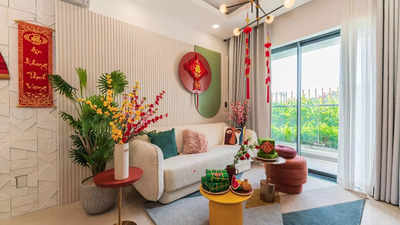- News
- lifestyle
- home-garden
- Blending the elegance of the past with contemporary trends of today for a timeless ambiance
Trending
Blending the elegance of the past with contemporary trends of today for a timeless ambiance
Traditional Indian design embraces bold, intricate details, while modern design favors minimalism and open spaces. Integrating elements such as carved jaalis, vibrant colors, and vintage lamps with sleek contemporary furnishings and lighting creates a balanced, sophisticated environment. This mix enhances visual interest and creates a harmonious, stylish space reflecting personal expression.

In designing real, the fusion of classic and contemporary has lately emerged as a captivating trend. The warmth of the traditional style and the charm of the modern design, leave an appealing impression, blending comfort and sophistication. Here are some ways to combine the two design techniques that express your style:
The architectural element
The architectural layout serves as the foundation of any design plan. Integrating the two styles right from the beginning creates a seamless and cohesive visual appeal throughout the space, making it look like a single unit. The intricate carved-out jaalis in the walls or windows, the sloping roofs and the high arches of Indian architecture, combined with the large window panels, asymmetrical structures and biophilic design of contemporary techniques, will give a fresh new look to your surroundings.
Traditional design features bold, bright colors, whereas contemporary design leans toward softer tones. These two palettes are at opposite ends of the spectrum, making it challenging to find the right balance for your space. Bold colors evoke warmth and coziness, making them ideal for areas like the study, entryway, and kitchen. A vibrant splash of bright shades on the walls of the living room and bedroom can create an engaging focal point. In contrast, cool tones, which promote a sense of calm and refreshment, are well-suited for living rooms and bedrooms. Pairing complementary colors on adjacent walls enhances vibrancy and adds dynamism to the space. Additionally, color combinations and visualizer tools from paint companies have become invaluable resources for consumers. Increasingly popular are colors inspired by heritage buildings and landmarks, such as Jodhpur Blue and Jaipuri Pink.
The lighting effect
Lighting is an essential part of the design and an inventive link to blend the two design styles. So, rather than opting for the basic CFLs and LED lights, channel your inner creative potential to experiment with different elements. To light up the space, add modern lighting for timeless glamour like hidden LED strips for floating shelves, liner cove lighting, sleek sconces and crystal chandeliers. Interactive light installations are another smart way to add an element of playfulness. Furthermore, to infuse a traditional touch to the interiors, include vintage lamps and hangings made of clay, terracotta, porcelain, brass, bronze, and silver in different parts of the house. These lighting choices will add a vintage appeal and depth to the surrounding.
The texture and finish
Mixing the rustic texture of the traditional styling and modern finish is key to creating a dynamic and interesting space. Classic materials like exposed wooden beams, jute rugs, natural stones and bamboo walls add character to the space. Meanwhile, the clean lines and minimalist approach of modern design such as glass finish, polished marble, and geometric patterned walls add a luxurious charm. The bend of the two distinct textures and finish will enhance visual interest and timeless appeal. Stone finish, concrete finish and interior designer finish is taking up shape recently in the texture category.
The furniture style
To create a contrasting blend, choose a traditional statement piece, such as a teak cabinet, an Indian ottoman, trunks, a wicker chair and a side table. The intricately carved, fine-quality wood and colourful fabric will infuse a sense of warmth and vibrancy into the interiors. Placing them strategically in different parts of the house will create a balance and promote a sense of tranquillity. A modern cushy sofa and coffee table at the centre of the living room will impart a modern look and match the colour palette of the area. Further, metal furniture on the balcony and outdoors will make your morning teas and sunsets more comfortable and enjoyable.
The statement pieces
Invest in statement pieces to bridge the gap between traditional and contemporary. These can be handmade artwork, antique jharokha, brass wall hanging, along with modern sculpture, mirrors, plant pots and more. When combined thoughtfully, they will draw the attention of all the guests and contribute to a cohesive and inviting atmosphere.
In conclusion, the beauty of interior design lies in the rich diversity of both traditional and contemporary styles. These styles can be skillfully blended to create an appealing and harmonious space, depending entirely on how you choose to combine them. There are no strict rules to follow when designing your environment; it’s all about creativity and self-expression.
By: Kuldip Raina, Director of Sales & Marketing at Shalimar Paints
End of Article
FOLLOW US ON SOCIAL MEDIA










